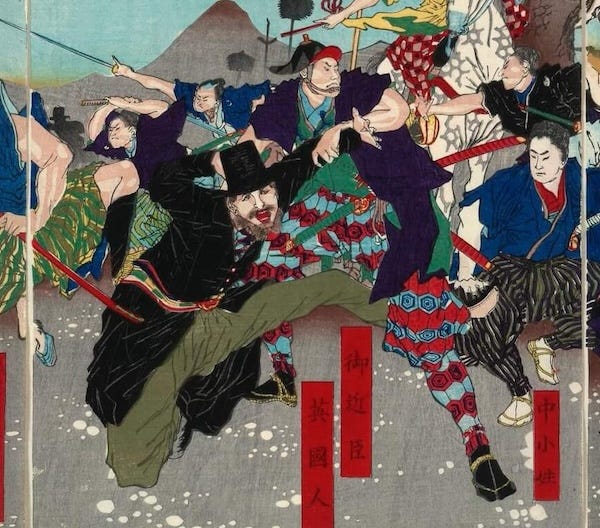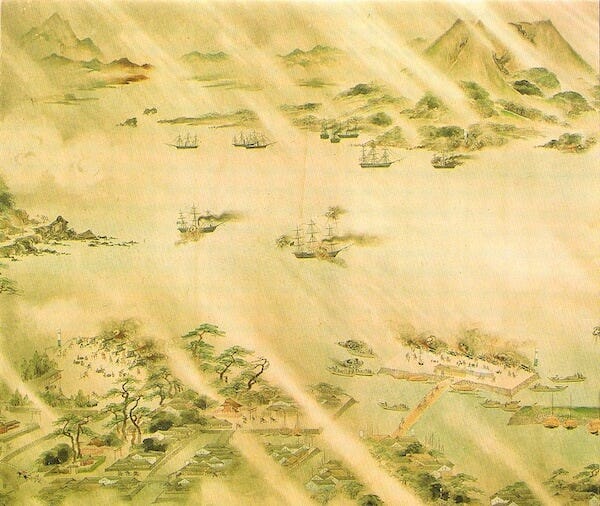⛩️ #29 That Time Japan & Britain Enjoyed a Two Day War
The Headlines, This Week in Japanese History, and Much More
We’ve all made social faux pas before in Japan.
But there’s a high likelihood, statistically, that you’ve never authored a blunder so egregious it resulted in your being summarily executed by a samurai security detail.
The story of one such gaffe, and the smart little war that ensued, is today’s feature story. We’ve also got your usual quiz, links, &c, &c.
Let’s splash into it:
THE QUIZ
A picture any Japanese person will recognize instantly — do you?
Question: who’s this guy?
Answer at the foot of the mail.
THE HISTORY
That Time Japan & Britain Enjoyed a Two Day War
Richardson gets thwacked for his faux pas. Detail from woodcut print The Killing at Namamugi. Image: Public Domain
This week in 1862 Charles Lennox Richardson, Esq. pissed off the wrong daimyo and found himself gutted on the road near Yokohama — leading to a smart little war between Japan and Great Britain.
Here are the basic agreed facts, before recriminations and accusations:
Richardson was a British trader who had just done a 14 year stint in Shanghai and was en route back to Blighty for retirement.
He stopped off in Yokohama, hooking up with two British merchants, Woodthorpe Charles Clark and William Marshall, to do the sights. Together with Marshall's sister-in-law Margaret Watson Borradaile they were traveling on the Tōkaidō road to visit the Kawasaki Daishi temple near Kawasaki.
On the road they encountered the large, armed retinue of Shimazu Hisamitsu, father of Shimazu Tadayoshi, the daimyō of the Satsuma Domain.
Richardson failed to dismount his horse, as was the law for Japanese people encountering a procession of big cheeses.
The Satsuma samurai took exception to this slight, and under the right to strike caste-law kiri-suté gomen (斬捨御免・切捨御免) one of them slashed Richardson up with his katana. Clark and Marshall were then also attacked.
Richardson, Clark and Marshall galloped away as fast as they could (leaving Borradaile, who was unharmed) — but Richardson fell from his horse mid-escape.
Shimazu gave the order for the todomé coupe de grâce (とどめ), and a dozen of his samurai skewered Richardson while he cowered helplessly on the ground, causing at least 14 wounds that each would have been fatal.
All in all, not a great start to Richardson’s retirement.
* * *
The ruling Tokugawa Shogunate had recently ended its historic isolationist foreign policy and allowed the entry of foreigners into Japan, then signed The Anglo-Japanese Treaty of Amity and Commerce (日英修好通商条約), which allowed the establishment of foreign concessions, minimal import taxes for foreign goods, plus extraterritoriality for foreigners, i.e. exemption from Japanese law.
In other words, Richardson might have caused offense, but the right to strike law should never have applied to him, and the Satsuma retainers were guilty of murder.
Thus what became known as the Nagamugi Incident, from the village where it occurred, created an international crisis.
The Japanese as you would think emphasized numbnutted Richardson’s cultural ignorance, and generally treated the whole brouhaha as deserved comeuppance to the foreigners who tended to strut around ignoring local law and custom.
The foreigner community in Japan, based in the Kannai district of Yokohama, were outraged by the killing. Having recently castigated Eugene Van Reed, an American who had dismounted and bowed before a daimyo’s procession, for undermining the entire community, they suddenly saw a future where they would be offed left and right by anyone who perceived a slight.
The British government demanded reparations from both the shogunate and the daimyo of Satsuma, plus the arrest, trial and execution of the perpetrators.
At first, they were ignored — but as dumb as Richardson had been not to understand the land he was in, the shogunate failed to understand the world they were in — and that Britain would not give up without a fight…or at least the money.
* * *
Japanese depiction of the bombardment of Kagoshima. Image: Public Domain
BOMBARDMENT OF KAGOSHIMA
After various negotiations failed, a British fleet commanded by Sir Augustus Leopold Kuper turned up outside Kagoshima, seat of the Satsuma Domain, ready to do the bailiff work the Royal Navy was famous for.
The Satsuma Domain's military forces responded by waiting until a typhoon began then launching an artillery bombardment from their coastal batteries towards the British ships. With typical British buffoonery, Kuper's squadron was astonished by the hostility, quickly lost 13 dead including a captain decapitated by a cannon ball, then, after bumbling around for a few hours, lobbing some shells back.
As is a historical certainly with Japanese armed conflicts, some entirely innocent Ryukyu (Okinawan) people got caught in the middle, losing 5 trading junks and an unrecorded number of dead.
5 Satsumans were killed on shore, roughly 500 houses were destroyed in Kagoshima and (of course) the Ryukyuan embassy was blown to bits.
Then Satsuma offered £25,000 reparations for the Richardson rub-out and the Royal Navy sailed off again, satisfied, ending the so-called Anglo-Satsuma War (薩英戦争).
Satsuma claimed the face-saving victory and also, no dummies, realized they’d probably need some of those nifty English boats in the near future should the increasingly enfeebled shogunate fall.
* * *
There are foreigners in Japan who believe that they and people like them are guests, who should act like it, and never complain about the country under any circumstances.
Then there are a hell of a lot of foreigners with their elbows on a bar most weeknights, bitching and complaining about the country, the people, the weather, the fact that their Japanese wife would rather lose a limb than contemplate the prospect of fellatio (this species usually being male).
Both positions come from a fundamental insecurity: the fear that Japan will not live up to their expectations. That’s while you’ll find the earnest Englishman who believed Richardson got exactly what he deserved, and the asshole who retains a secret fantasy of their home country’s government crashing in to avenge them when they get drunk and insult the wrong tattooed gentleman and end up slashed to ribbons in a back alley.
We at The Kyote tend to skate the middle lane, testifying to our love to Japan warts and all because we believe it stands the scrutiny.
* * *
Satsuma paid the £25,000 reparations by borrowing it from the shogunate, which quickly fell and was replaced with the Meiji government, so they never had to pay back the cash.
Richardson never made it back to Britain. He was buried in the Yokohama Foreign Cemetery between the later graves of Marshall and Clarke, his companions on the fateful day.
Richardson's killers never faced justice.
Good old Britain, with its traditional insistence on truth and justice, quickly (heroically) overcame the loss of the martyred Richardson and signed a treaty with Satsuma to supply them with steam warships and weapons during the Boshin War — netting another huge cash windfall for the exchequer of Queen Victoria. Rule Britannia!
More here: Wikipedia
THE LANGUAGE
5 German Medical Terms Used in Japanese Hospitals
Japan cut itself off from the world for a fair old period there, but once they realized how drastically other nations had surpassed them the race to catch up began.
Germany was considered the 19th century leader in medicine, so into Japan poured platoons of physicians ready to teach in newly established medical schools – and that’s why many German-derived terms still remain in use today. Here’s 5 that might help you navigate an incipient medical crisis:
1️⃣ Mesu メス
A mesu is what a surgeon uses to make their incisions.
Meaning: scalpel
German original: Messer
2️⃣ Gāzé ガーゼ
Wound or scrape? Cover it with gāzé.
Meaning: gauze
German original: Gaze
3️⃣ Gips ギプス
Break a limb and you’ll probably end up flailing around in a gips for a while.
Meaning: plaster cast
German original: Gips
4️⃣ Kanūré カニューレ
This one’s almost the same as the English: those tubes they stick up your nostrils when you’re on oxygen.
Meaning: cannula
German original: Kanüle
5️⃣ Karuté カルテ
…and meanwhile all of your ailments will be recorded in your karuté.
Meaning: medical records
German original: Karte
THE LINKS
3 things worth your time about Japan:
Official Japan often struggles with foreign language proficiency — leading to affairs like the Chinese worker at national broadcaster NHK who slipped anti-Japanese messages into live broadcasts
Inside a Japanese prison: where the rare young inmate gets care home qualifications in order to look after the skads of aging gangsters
Jack Krown on the “hot suffocating drench” that this summer has been.
THE ANSWER
Question: who’s this guy?
Answer: Edo-period Amazon Prime. Hikyaku (飛脚, literally “flying feet”) were express couriers who sprinted up and down the Tokaidō highway, handing on their deliveries to the next hikyaku waiting at each rest station.
Enjoy The Kyote this time? Check this out next: Four New Geniuses of Japanese Comedy
We’ll see each other again next week,
The Kyote
Comment? Just Hit Reply
The Kyote is published in Kyoto, Japan every Sunday at 19:00 JST













Let's not forget レントゲン, also from the German. When I was hospitalized in Tokyo many years ago, it was that word that made the German medical connection click for me, after which I finally began to understand more of what my hapless doctor at a small Catholic hospital was saying. (She was hapless in that she didn't have enough of a background in hematology to understand my symptoms—it was only after I was transferred to a ward hospital that the diagnosis—mononucleosis!—was clarified.
And cool information on the Satsuma domain. Explains a lot about how they came to dominate Emperor Meiji's new navy.